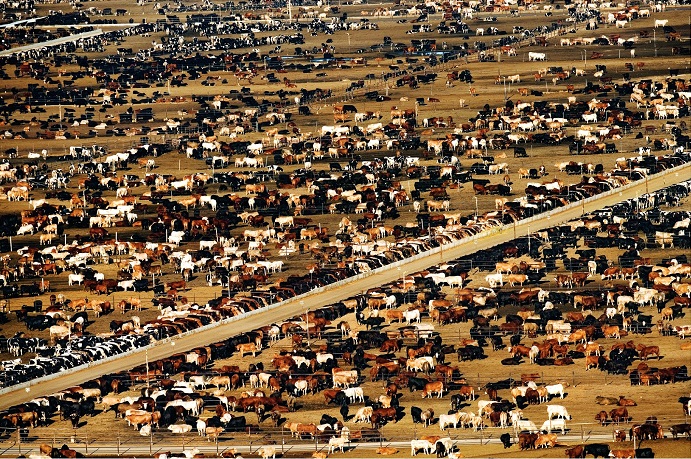
Chapter 21. Chapter 21: Agriculture: Raising Livestock
What agricultural policies have been pursued in the United States...?

Guiding Question 21.4
What agricultural policies have been pursued in the United States, and what practices do they promote? What policy recommendations does the FAO make regarding livestock rearing choices?
Why You Should Care
Laws passed during the Great Depression, especially the U.S. Farm Bill, were originally intended to protect the interests of small-scale farmers by paying them to produce less. This may not make a lot of sense at first, but in times of surplus, producing less will keep demand and profits higher than producing all that one's farm will allow. That means that farmers make more money and can stay in business. However, somewhere along the way, the system began to break down. Loopholes and changes in the Farm Bill and other policies began to subsidize farmers producing too much or producing at greater cost than their crops were worth. Eventually, industries began to take advantage of the surplus of artificially inexpensive corn, soybeans, and other “commodity crops.” They found ways to turn corn into convenience and snack foods, and feeding cattle grain rather than grass became standard practice. The origin of the CAFO method, then, became a viable option because companies could purchase corn at less than cost and use it to grow more beef in less space. Helping this effort were gaps in drug and environmental policies that allowed CAFO owners to use antibiotics almost indiscriminately and to avoid treating animal waste with the stringent standards set for municipal wastewater. Some of these policies have recently been changed, so it will be interesting to see if CAFO methods will become more environmentally responsible. The United Nations Food and Agriculture Organization recommends just that. It is the FAO's recommendation that wealthy nations such as the United States, where the nutritional needs of citizens have largely been met, should focus policies on reducing the environmental impact of meat production. This would mean a shift to more grass-fed meat and perhaps an education campaign about the advantages of non-industrial methods.
1.
What are the two pairs of opposing concerns one must consider when drawing up agricultural policy presented in this graph? (Choose two)
a. Food security vs. environmental concerns
b. Food security vs. food Safety
c. Food safety vs. livelihood
d. Food safety vs. environmental concerns
2.
Based on context clues from Infographic 21.6 and elsewhere in Chapter 21, you might correctly deduce that “the stable accessibility to a household of adequate amounts of food, both in terms of calories and nutrition” defines the term:
| A. |
| B. |
| C. |
| D. |
3.
Based on the recommendations presented in Infographic 21.6, policy objectives for ________ countries should be more balanced between the needs for food security, food safety, livelihood, and environment protection than for other groups of countries.
| A. |
| B. |
| C. |
| D. |
4.
In developed, post-industrial countries, policy should focus on:
| A. |
| B. |
| C. |
| D. |
5.
Thought Question: In post-industrial countries, food safety is more of a policy concern than food security, whereas in developing countries, the opposite is true. Explain why this is true. Are there any hidden ethical dilemmas in these policy recommendations?
Activity results are being submitted...